Introduction
Much attention has been paid of late to AMD‘s new 6-core desktop CPU, the Phenom II X6 1090T. While its performance is certainly impressive, its price—over $300 at time of publication—can be off-putting to many system builders. For those whose wallets run a bit leaner these days, AMD has brought us the Athlon II X4 640. This quad-core CPU promises good performance at a low price. Let’s take a closer look, and see how it stacks up.
Specifications
First, let’s take a look at the raw numbers from AMD:
AMD Athlon II(tm) X4 640 Processor Specifications: Model Number, Core Frequency & Price: X4 640 / 3.0GHz Tray OPNs: ADX640WFK42GM L1 Cache Sizes: 64K of L1 instruction and 64K of L1 data cache per core (512KB total L1 per processor) L2 Cache Sizes: 512KB of L2 data cache per core (2MB total L2 per processor) Memory Controller Type: Integrated 128-bit wide memory controller * Memory Controller Speed: Up to 2.0GHz with Dual Dynamic Power Management Types of Memory Supported: Unregistered DIMMs up to PC2-8500 (DDR2-1066MHz) -AND- PC3-10600 (DDR3-1333MHz) HyperTransport 3.0 Specification: One 16-bit/16-bit link @ up to 4.0GHz full duplex (2.0GHz x2) Total Processor-to-System Bandwidth: Up to 37.3GB/s total bandwidth [Up to 21.3 GB/s memory bandwidth (DDR3-1333) + 16.0GB/s (HT3)] Up to 33.1GB/s total bandwidth [Up to 17.1 GB/s memory bandwidth (DDR2-1066) + 16.0GB/s (HT3)] Packaging: Socket AM3 938-pin organic micro pin grid array (micro-PGA) Fab location: GLOBALFOUNDARIES Fab 1 module 1 in Dresden, Germany Process Technology: 45-nanometer DSL SOI (silicon-on-insulator) technology Approximate Die Size: 169 mm2 Approximate Transistor count: ~300 million Max Temp: 71° Celsius Nominal Voltage: 1.05-1.4V Max TDP: 95 Watts AMD Codename: “Propus” *Note: configurable for dual 64-bit channels for simultaneous read/writes
As with all of AMD’s AM3 offerings, the X4 640 supports the fastest varieties of both DDR2 and DDR3 DRAM with its onboard memory controller. Which kind of RAM you use will be determined by the motherboard, as the two are deliberately not socket-compatible. With a 95W TDP, power consumption is firmly in the upper-middle end of AMD’s line, with only the new hexa-core Phenom II chips drawing more. Massive tower heatsinks or watercooling solutions are not needed with this CPU, but an aftermarket cooler will help greatly in keeping things cool.
Test Setup & CPU-Z Info
Testing was conducted with the following system:
| CPU | AMD Athlon II X4 640 |
| Heatsink | GlacialTech Igloo 5760 |
| Motherboard | Jetway Hummer HA-09 |
| Chipset | AMD 890GX |
| Graphics card | ATI Radeon HD 4830 |
| RAM | 2x2GB Kingston DDR3-1066 |
| HDD 1 | Seagate 7200.10 500GB |
| HDD 2 | Western Digital Caviar Green 5900RPM 500GB |
| Power Supply | Nexus RX-6300 630W |
| Case | Silverstone Fortress FT-02 |
| OS | Windows 7 Ultimate |
| Drivers | Catalyst 10.4 unified drivers |
Note: In order to get the system stable, we were forced to disable C1E power state support in the BIOS settings. This disables AMD’s Cool-n-Quiet cpu throttling, but was needed to avoid frequent lockups and random reboots. Feel free to consult your friendly neighborhood Spid—er, Google about the “AMD C1E bug” for further details.
For those who must have every last gory detail, CPU-Z gives us a thorough breakdown of the CPU’s capabilities:
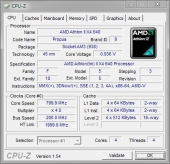
SiSoft Sandra
SiSoftware’s Sandra benchmarking suite has been a staple in the industry for years, providing a detailed look at the performance of each part of a system.
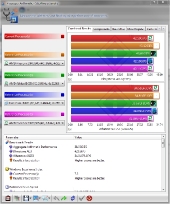
On this test, the X4 640 held even with the competition, delivering very solid numbers.
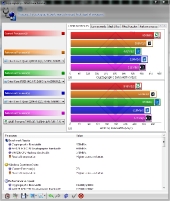
Here the X4 640 had an odd high-low split, pulling significantly ahead on the AES-128 encryption test, but falling behind on the SHA-256 hashing test.
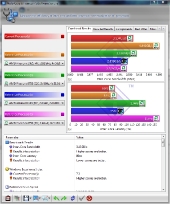
Here the X4 640 continues AMD’s trend of lagging behind on inter-core communication, posting significantly worse numbers than Intel’s offerings on inter-core bandwidth and latency.
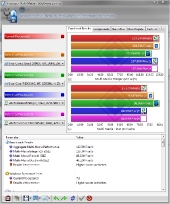
There wasn’t much of a spread here, with the X4 640 only lagging slightly behind Intel’s offerings on the floating-point multimedia test.
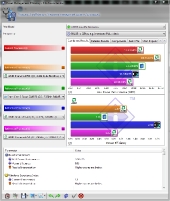
Because of the noted problem with C1E support, the power efficiency results should be disregarded, as the X4 640 was operating without benefit of CPU frequency scaling.
PCMark Vantage
Futuremark’s PCMark Vantage does quite the thorough evaluation, testing your system on a number of practical applications. Unfortunately, it completely fails to report its findings in a useful format, instead opting to assign arbitrary score numbers that are largely meaningless. Still, run enough systems through the same benchmark and you’ll start to see some trends in comparison. Here’s the score for our test system:

3DMark 06 & Vantage
3DMark 06 is quite old now, as such things go, but it remains relevant due to the large number of games that operate in DirectX9 mode. As with PCMark, it doesn’t report its findings in any objective fashion, but comparisons can still be made:

3DMark Vantage is still the newest iteration of the 3DMark benchmark, offering a look at how games that support DirectX10 will perform. Note that the scores for any 3DMark result will be affected as much—if not more—by your choice of video card as they will by your CPU.

WinRAR
Perhaps one of the most common tasks in a computer user’s day is moving files around. Archive formats like RAR and 7zip offer a convenient way to package up files and send them over the internet, but getting the files back out again means unpacking the archive, a task where the CPU is quite important:
According to WinRAR’s inbuilt testing, the X4 640 managed to crunch through nearly 1.8MB/sec, quite a respectable rate for RAR’s high-compression format.
Cinebench 11.5
Maxon’s Cinebench software is based off their Cinema4D 3D rendering suite, which is often employed to produce high-quality computer-generated graphics for movies and TV. Cinema4D, and by extension Cinebench, can scale to utilize up to 64 CPU cores. This offers a clear look at the benefits of parallel processing, and how a good multi-core CPU can speed your workflow. Their scoring is as arbitrary as any, but simply watching the test render will give you a clear idea of the speed you can expect from the full product.

Here the multicore test showed a 3.89x speed multiplier over the single-thread render, which is very close to the theoretical ideal. Perfect 1:1 speedup is not possible on multicore systems, due to inter-core communication overhead, but the results show that the X4 640 isn’t wasting a lot of time talking to itself while under load.
Crysis Warhead

It’s difficult to find a game that truly stresses the CPU these days, as more and more of the work is being moved to the GPU. Still, CryTek’s engine finds plenty of work for the CPU to do while the GPU staggers under its monstrous load. For this test, we ran a number of timedemos in two of the game’s most demanding levels, ambush and avalanche, in both DirectX 9 and DirectX 10 modes. To try to eliminate statistical outliers, we ran each timedemo three times at the indicated settings. With the resolution set at 1680x1050noAA and all presets set at Gamer (medium-high), framerates averaged thus:
| Level | Frames per second |
| Ambush (DX9) | Min: 18.50 Max: 33.63 Avg: 26.14 |
| Ambush (DX10) | Min: 1.14 Max: 30.09 Avg: 23.05 |
| Avalanche (DX9) | Min: 15.89 Max: 38.46 Avg: 29.08 |
| Avalanche (DX10) | Min: 18.48 Max: 35.45 Avg: 26.77 |
As expected for a mid-level 4800 series Radeon card, the framerates are playable, if slightly choppy. The unusually low minimum fromerate on Ambush (DX10) was caused by a persistent hitch in loading at the beginning of the level. Once it got going, the framerate stayed steady in the low 20s, which is on the low side of playable for most singleplayer FPS games. Shrapnel-heavy grenade blasts and other physics interactions, which the CryEngine handles on the CPU, went off without any noticeable slowdowns. Again, please note that the raw horsepower of the graphics card is at least as important as the CPU for high-resolution gaming.
Thoughts and Conclusion
I will admit, I was biased against this CPU slightly from the start. Having grown accustomed to the power of AMD’s Phenom II line, I had thought that the Athlon II X4 640 would prove to be a bottleneck. The testing we outlined above, as well as a week of intensive personal use, has quite thoroughly disabused me of that notion. This CPU easily holds its own against any of AMD’s earlier mid-level Phenom II CPUs, and manages to go toe-to-toe with Intel’s Core i5 line on an even footing. With an approximate retail price of $120, this CPU easily beats out Intel’s mid-range offerings for those looking to get the most power out of every dollar.

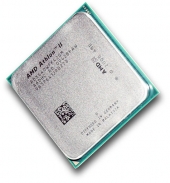




Anyone have the foggiest idea what this says?